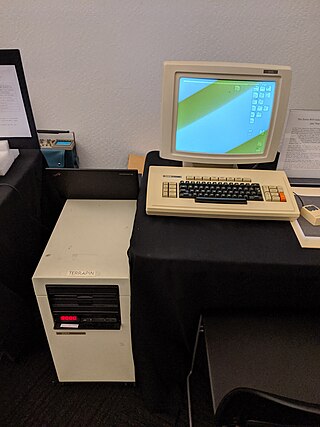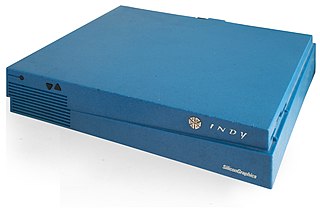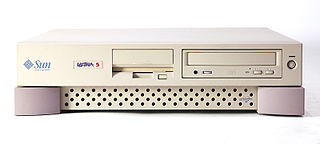
Lisp machines are general-purpose computers designed to efficiently run Lisp as their main software and programming language, usually via hardware support. They are an example of a high-level language computer architecture. In a sense, they were the first commercial single-user workstations. Despite being modest in number Lisp machines commercially pioneered many now-commonplace technologies, including effective garbage collection, laser printing, windowing systems, computer mice, high-resolution bit-mapped raster graphics, computer graphic rendering, and networking innovations such as Chaosnet. Several firms built and sold Lisp machines in the 1980s: Symbolics, Lisp Machines Incorporated, Texas Instruments, and Xerox. The operating systems were written in Lisp Machine Lisp, Interlisp (Xerox), and later partly in Common Lisp.
Mesa is a programming language developed in the mid 1970s at the Xerox Palo Alto Research Center in Palo Alto, California, United States. The language name was a pun based upon the programming language catchphrases of the time, because Mesa is a "high level" programming language.

A workstation is a special computer designed for technical or scientific applications. Intended primarily to be used by a single user, they are commonly connected to a local area network and run multi-user operating systems. The term workstation has been used loosely to refer to everything from a mainframe computer terminal to a PC connected to a network, but the most common form refers to the class of hardware offered by several current and defunct companies such as Sun Microsystems, Silicon Graphics, Apollo Computer, DEC, HP, NeXT, and IBM which powered the 3D computer graphics revolution of the late 1990s.

Butler W. Lampson FRS is an American computer scientist best known for his contributions to the development and implementation of distributed personal computing.

The Xerox Alto is a computer system developed at Xerox PARC in the 1970s. It is considered one of the first workstations or personal computers, and its development pioneered many aspects of modern computing. It features a graphical user interface (GUI), a mouse, Ethernet networking, and the ability to run multiple applications simultaneously. It is one of the first computers to use a WYSIWYG text editor and has a bit-mapped display. The Alto did not succeed commercially, but it had a significant influence on the development of future computer systems.

The Xerox Star workstation, officially named Xerox 8010 Information System, is the first commercial personal computer to incorporate technologies that have since become standard in personal computers, including a bitmapped display, a window-based graphical user interface, icons, folders, mouse (two-button), Ethernet networking, file servers, print servers, and email.
Apollo/Domain is a series of workstations that were developed and produced by Apollo Computer from c. 1980 to 1989. The machines were built around the Motorola 68k series of processors, except for the DN10000, which has from one to four of Apollo's RISC processors, named PRISM.
Interlisp is a programming environment built around a version of the programming language Lisp. Interlisp development began in 1966 at Bolt, Beranek and Newman in Cambridge, Massachusetts with Lisp implemented for the Digital Equipment Corporation (DEC) PDP-1 computer by Danny Bobrow and D. L. Murphy. In 1970, Alice K. Hartley implemented BBN LISP, which ran on PDP-10 machines running the operating system TENEX. In 1973, when Danny Bobrow, Warren Teitelman and Ronald Kaplan moved from BBN to the Xerox Palo Alto Research Center (PARC), it was renamed Interlisp. Interlisp became a popular Lisp development tool for artificial intelligence (AI) researchers at Stanford University and elsewhere in the community of the Defense Advanced Research Projects Agency (DARPA). Interlisp was notable for integrating interactive development tools into an integrated development environment (IDE), such as a debugger, an automatic correction tool for simple errors, and analysis tools.

The Indy, code-named "Guinness", is a low-end multimedia workstation introduced on July 12, 1993 by Silicon Graphics Incorporated (SGI). SGI developed, manufactured, and marketed Indy as the lowest end of its product line, for computer-aided design (CAD), desktop publishing, and multimedia markets. It competed with Intel x86 computers, and with Windows and Macintosh, including using their files and running their applications via software emulation. It is the first computer to come standard with a video camera, called IndyCam.

RISC iX is a discontinued Unix operating system designed to run on a series of workstations based on the Acorn Archimedes microcomputer. Heavily based on 4.3BSD, it was initially completed in 1988, a year after Arthur but before RISC OS. It was introduced in the ARM2-based R140 workstation in 1989, followed up by the ARM3-based R200-series workstations in 1990.

The PERQ, also referred to as the Three Rivers PERQ or ICL PERQ, is a pioneering workstation computer produced in the late 1970s through the early 1980s. It is the first commercially-produced personal workstation with a graphical user interface (GUI). The design of the PERQ was heavily influenced by the original workstation computer, the Xerox Alto, which was never commercially produced. The workstation was conceived by six former Carnegie Mellon University alumni and employees: Brian S. Rosen, James R. Teter, William H. Broadley, J. Stanley Kriz, Raj Reddy and Paul G. Newbury, who formed the startup Three Rivers Computer Corporation (3RCC) in 1974.

The IBM RT PC is a family of workstation computers from IBM introduced in 1986. These were the first commercial computers from IBM that were based on a reduced instruction set computer (RISC) architecture. The RT PC uses IBM's proprietary ROMP microprocessor, which commercialized technologies pioneered by IBM Research's 801 experimental minicomputer. The RT PC runs three operating systems: AIX, the Academic Operating System (AOS), and Pick.
DeskStation Technology was a manufacturer of RISC-based computer workstations intended to run Windows NT. DeskStation was based in Lenexa, Kansas.
Parallels Workstation is the first commercial software product released by Parallels, Inc., a developer of desktop and server virtualization software. The Workstation software comprises a virtual machine suite for Intel x86-compatible computers which allows the simultaneous creation and execution of multiple x86 virtual computers. They distributed the product as a download package. Parallels Workstation has been discontinued for Windows and Linux as of 2013.
The Apple Network Server (ANS) was a line of PowerPC-based server computers designed, manufactured and sold by Apple Computer, Inc. from February 1996 to April 1997. It was codenamed "Shiner" and originally consisted of two models, the Network Server 500/132 and the Network Server 700/150, which got a companion model, the Network Server 700/200 with a faster CPU in November 1996.

The Sun386i is a discontinued hybrid UNIX workstation/PC compatible computer system produced by Sun Microsystems, launched in 1988. It is based on the Intel 80386 microprocessor but shares many features with the contemporary Sun-3 series systems.

The Ultra 5 and Ultra 10 are 64-bit Sun Microsystems workstations based on the UltraSPARC IIi microprocessor available since January 1998 and last shipped in November 2002. They were introduced as the Darwin line of workstations.

The Sun Microsystems Ultra 80 is a computer workstation that shipped from November 1999 to 2002.
The Commodore PC compatible systems are a range of IBM PC compatible personal computers introduced in 1984 by home computer manufacturer Commodore Business Machines.

The history of the personal computer as a mass-market consumer electronic device began with the microcomputer revolution of the 1970s. A personal computer is one intended for interactive individual use, as opposed to a mainframe computer where the end user's requests are filtered through operating staff, or a time-sharing system in which one large processor is shared by many individuals. After the development of the microprocessor, individual personal computers were low enough in cost that they eventually became affordable consumer goods. Early personal computers – generally called microcomputers – were sold often in electronic kit form and in limited numbers, and were of interest mostly to hobbyists and technicians.













